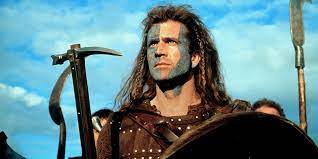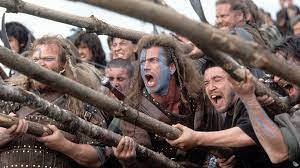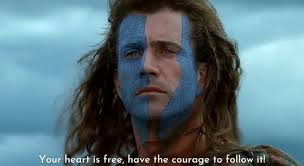🎬 Braveheart (1995)

Braveheart (1995) Review
Introduction
Directed by and starring Mel Gibson, Braveheart (1995) is a sweeping historical epic that dramatizes the life of William Wallace, a 13th-century Scottish warrior who led a rebellion against English oppression. Known for its breathtaking battle sequences, emotionally charged storytelling, and stirring themes of freedom and sacrifice, the film became an instant classic, earning five Academy Awards, including Best Picture and Best Director.
Plot Overview
The film opens with young William Wallace witnessing the brutal execution of his family and fellow Scots under the oppressive rule of King Edward I of England, also known as “Longshanks.” After years of exile, Wallace (Mel Gibson) returns to his homeland, seeking a peaceful life. However, the murder of his beloved wife, Murron (Catherine McCormack), at the hands of English soldiers ignites his desire for vengeance.
Wallace becomes the leader of a Scottish rebellion, rallying clans and peasants to fight for freedom. His tactical brilliance and unyielding determination lead to stunning victories against the English army, but internal betrayal and political machinations threaten to undermine his cause. The film culminates in Wallace’s capture, trial, and execution, solidifying him as a martyr and symbol of Scottish independence.
Strengths
1. Mel Gibson’s Commanding Performance
Gibson delivers a powerful performance as William Wallace, balancing the character’s ferocity in battle with moments of tenderness and vulnerability. His ability to convey Wallace’s unwavering conviction makes him a compelling and inspiring protagonist.
2. Epic Battle Sequences
The film’s large-scale battles, particularly the Battle of Stirling Bridge, are masterfully choreographed and intensely visceral. The use of practical effects, detailed costumes, and immersive sound design captures the chaos and brutality of medieval warfare.
3. Emotional Depth
While Braveheart is known for its action, its emotional core lies in the personal relationships and sacrifices that drive Wallace’s crusade. The romance between Wallace and Murron, as well as his camaraderie with his fellow Scots, adds depth and humanity to the story.
4. Stirring Musical Score
James Horner’s iconic score is a vital component of the film’s emotional impact. The hauntingly beautiful melodies evoke the sweeping landscapes of Scotland and the profound themes of love, loss, and freedom.
5. Cinematography and Production Design
John Toll’s cinematography captures the rugged beauty of Scotland’s landscapes, enhancing the film’s epic scale. The meticulous production design, from the period-accurate costumes to the detailed sets, immerses viewers in the medieval era.
Weaknesses
1. Historical Inaccuracies
While the film is a rousing historical drama, its deviations from historical facts have been widely criticized. Key events, character portrayals, and timelines are dramatized or altered for cinematic effect, which may detract from its authenticity for history enthusiasts.
2. Simplistic Characterization of Villains
The English characters, particularly King Edward I, are depicted as one-dimensional villains. While this serves the narrative’s purpose, it diminishes the complexity of the conflict by reducing the antagonists to caricatures.
3. Pacing Issues
At a runtime of nearly three hours, the film occasionally lingers on certain subplots, which can slow the pacing. Some viewers may find these moments detract from the film’s momentum.
Themes and Symbolism
1. Freedom and Sacrifice
At its core, Braveheart is a tribute to the fight for freedom and the sacrifices made in its pursuit. Wallace’s unwavering commitment to his cause inspires others to rise against tyranny, embodying the universal struggle for self-determination.
2. Legacy and Immortality
The film explores the idea that true heroism lies in creating a legacy that outlives one’s own life. Wallace’s death transforms him into a symbol of resistance, ensuring his story endures.
3. Love as Motivation
The love between Wallace and Murron serves as the catalyst for his rebellion, emphasizing the personal stakes behind his larger political mission. This theme underscores the human cost of conflict.
Visual and Technical Aspects
1. Battle Realism
The film’s commitment to practical effects and realistic combat choreography creates a visceral and authentic depiction of medieval warfare. The attention to detail in armor, weaponry, and tactics heightens the intensity.
2. Sound Design
The immersive sound design enhances the film’s atmosphere, from the clash of swords to the roar of charging armies. Combined with the score, the audio elements bring the battle sequences and emotional moments to life.
3. Editing
Despite its extended runtime, the film’s editing effectively balances large-scale action with intimate character moments, ensuring the story remains cohesive and engaging.
Final Verdict
Braveheart (1995) is a cinematic triumph that combines thrilling action, compelling performances, and heartfelt storytelling. While its historical inaccuracies and simplistic antagonists may draw criticism, the film’s emotional resonance and epic scope solidify its place as a classic of the historical drama genre. With its unforgettable battle sequences and iconic rallying cry of “Freedom!” Braveheart remains a stirring and inspiring tale of courage and sacrifice.
Rating: 9/10